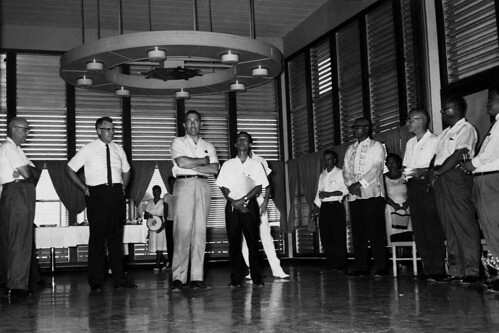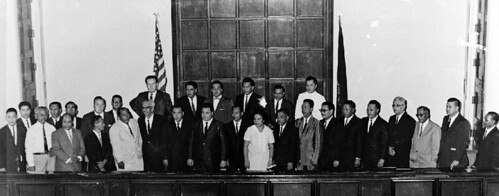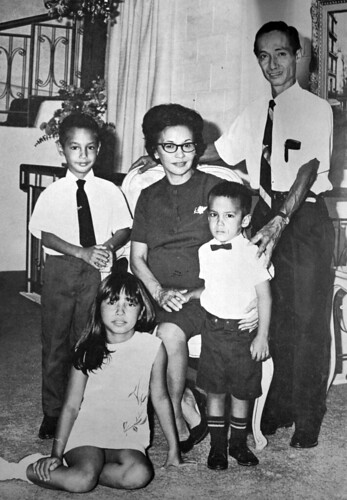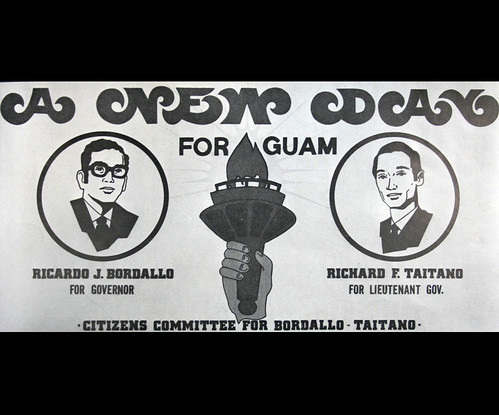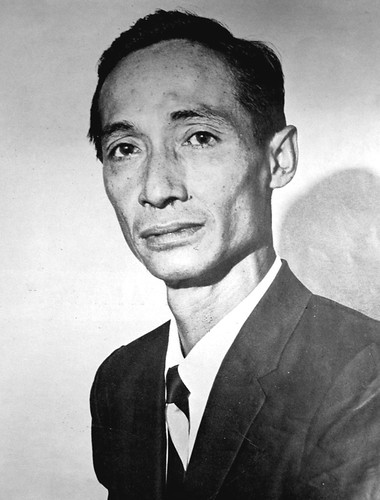Richard Flores Taitano
View more photos for the Richard Flores Taitano entry here.
Richard Flores “Dick” Taitano was a prominent figure in Guam politics and community service following the establishment of the civilian government on Guam. Taitano was a six-term member of the Guam Legislature in the 1960s and 1970s. He was also the first Chamorro to be appointed to serve as the director of the Office of Territories (OOT) in the United States Department of Interior.
Early life and career
Taitano was born on 14 May 1921 in Hagåtña to Rosario Sablan Flores and John (Juan) San Nicolas Taitano of Dededo, and was the seventh of fifteen children. He was raised Baptist in a predominantly Catholic island, along with his brothers and sisters: Rosario T. Sablan, Isabel T. Guerrero, Carlos F. Taitano, Josefa P. Taitano, Catalina T. Aguon, John F. Taitano, Jane F. Taitano, Frank F. Taitano, Rosa T. Murphy, Esther T. Underwood, Joseph F. Taitano, Henry F. Taitano, Candelaria T. Rios, and William F. Taitano. Like other members of the “Kueto” family clan—known for their hard work and sharp intellect—Dick Taitano had a reputation as a bright, hardworking individual who also had a strong wit.
Taitano attended the Guam Institute, a prewar private school in Hagåtña, and later graduated from George Washington High School in 1940. He went on to attend Berea College in Berea, Kentucky, from 1946 to 1949 where he received his Bachelor’s degree. He also studied governmental administration at the prestigious Institute of Local and State Government Wharton School, University of Pennsylvania, from 1949 to 1950. Taitano was a member of Pi Gamma Mu (Social Science) in 1948 and was an honored Felis Scholar at UPenn in 1949. He earned a Phi Kappa Phi scholarship in 1963, and was honored with a Doctor of Law, honoris causa, from the University of Guam in 1984.
Taitano actually had begun his professional career as a teacher in Guam public schools from 1937 to 1940. He was only a ninth grader when he started teaching, but still managed to graduate as class valedictorian. He later worked as a messenger clerk at the US Naval Station, and also as a surveyor and draftsman for the Department of Public Works shortly before World War II began in Guam in 1941. During the war he farmed with his family and returned to government service in 1945 as a postal clerk before leaving for college in 1947.
Taitano was one of the first young people to leave Guam for a college education in the US at the start of the postwar era. However, Guam’s pre-Organic Act status made residents like Taitano difficult to categorize when he arrived in Honolulu on his way to Kentucky. Because he had no birth certificate with him, Taitano was detained by Immigration Officers until the Navy on Guam verified his origin. Upon his release he was directed to register for the selective service when he arrived in Kentucky, but officials there again were confused with his status, so they categorized him as a foreign student. As a foreign student, he did not have to register for the draft but needed to check in regularly with the Office of Immigration. When the Organic Act was signed in 1950 granting Chamorro residents of Guam American citizenship, Taitano stopped checking in with Immigration, and was arrested briefly for not reporting as a foreign student. Taitano then presented FBI agents with a copy of the Organic Act to prove his US citizenship.
For a brief time in 1950, Taitano worked at the Department of Interior before returning to Guam. His employment with the island’s new civilian government began with a stint as an economic trainee at the Guam Department of Commerce, and as an assistant budget officer from 1951 to 1952. He was appointed Director of the Guam Department of Finance, as well as ex-officio Insurance and Welfare Director from 1952 to 1961. In 1953 he was appointed Delegate to the White House Conference on the Aging, and was a member of the American Delegation of the Office of the Conference in 1959.
Taitano was the first Chamorro to be appointed director of the Department of Finance. At that time, all Government of Guam salaries were paid for by the federal government. As director, Taitano was responsible for overseeing the salaries and expenses of the civilian government, including the senators serving in the Guam Legislature who had to justify their expenses with him. Taitano remained Director of Finance until 1961 when he was appointed to the Department of Interior.
Appointment to the Department of Interior
Taitano’s appointment to the Department of Interior was to the highest federal position ever held by a Chamorro at the time. He served as Director of the Office of Territories during the administration of President John F. Kennedy in 1961 until 1964. Taitano had replaced Anthony T. Lausi who was appointed during the Eisenhower administration. Taitano’s appointment came at the recommendation of Guam Governor Carlton Skinner under whom Taitano served in 1952. Skinner made the recommendation to Interior Secretary Stewart Udall.
In his capacity as Director, Taitano was responsible for the general administration of Guam, the islands of the Pacific Trust Territory (USTTPI), American Samoa and the US Virgin Islands. He undertook special assignments, including that of President Kennedy’s special ambassador to Western Samoa during their independence ceremonies in 1962. He was a member of the White House Survey Mission to the Trust Territory in 1963, and a member of the US delegation to the Third South Pacific Conference. In 1980, Taitano, looking back on his years of public service, declared he was most pleased about his stint with the Office of Territories (OTT): “I was building and dreaming up things, and getting things going.”
While at the Department of Interior, major breakthroughs occurred regarding the liberalization of federal control over Guam, including the lifting of the Navy security clearance and the acceptance by the White House of an elected governor for Guam, which Taitano enthusiastically supported. He resigned from his position as Director of OTT in 1964. From 1964-1966, Taitano was appointed by President Lyndon Johnson to be Deputy High Commissioner of the Trust Territory of the Pacific Islands and moved with his family to the headquarters in Saipan. Here, Taitano participated in the development of the political statuses for the different island nations of Micronesia. Afterward, he returned to Guam and served under Governor Manuel F.L. Guerrero as an Assistant to the Governor for Economic Development.
Legislative leader
In 1966, Taitano left his position with Governor Guerrero and ran for a seat in the 9th Guam Legislature, which he won. Additionally, Taitano was elected to the 10th, 12th 13th, 14th and 15th Guam Legislatures and served on numerous committees. He was Chairman of the Standing Committee on Resources and Development and was Vice-Chairman of the Standing Committee of Finance and Taxation. He was also a member of the Committee on Rules for the 9th, 10th and 12th Guam Legislatures. Taitano also served on Select Committees on Hospital and Charges; Insurance Policies; Study on the Desirability to Change the Length of Session of the Legislature; and on Multimedia Projects and the Legislative journal.
During his terms as a senator, Taitano introduced dozens of legislative bills that have had a lasting impact on Guam and its people, including the establishment of a Uniform Consumer Credit Code, the Micronesian Cultural Fair, a Land Survey Fund, and the Micronesian Area Research Center (MARC). Taitano also initiated bills to establish a Land Condemnation Fund, group insurance benefits for Government of Guam retirees, and a civil code to regulate inns, hotels and apartments. He also introduced a bill to make Guam the first jurisdiction to prohibit the use of the harmful pesticide DDT.
Taitano also proposed several bills that sought to improve transparency and efficiency of governmental operations, including legislative audits, orderly and equitable procedures of adjudication for contested GovGuam cases, and disclosure of conflicts of interest for GovGuam offices and employees.
He helped create the Office of the Suruhanu (Ombudsman). Taken from the Chamorro word for traditional healer, the Suruhanu’s office was meant to correct and solve individual problems citizens may have had with GovGuam by providing a method of open access to experts and ensure citizens’ complaints were addressed to the proper agency or authority. Taitano also submitted bills that made public hearings of legislative bills mandatory and eliminated illegal expenditures of government funds. He also called for the submission of financial disclosures by legislative candidates as well as the disclosure and regulation of campaign contributions by corporations. In addition, Taitano advocated for the submission of annual reports by department and agency heads.
Taitano held numerous leadership roles in various civic organizations on the island. He served as past president of the Guam Chapter of the American Red Cross and the Guam Fine Arts Society. He was a member of the Delta Sigma Society, fundraising chair of the American Red Cross, and the first vice-president of the American Red Cross. Taitano was also a delegate to the Democratic National Presidential Convention held in Chicago in 1968 and was state Chairman of the Democratic party of Guam from 1967 to 1969.
Run for lieutenant governor
Although considered the “underdog,” in 1970, Taitano paired up with Senator Ricardo J. Bordallo to run for the position of lieutenant governor in a hard fought race for the first elected governor of Guam. At the time, Guam’s Democratic Party claimed about 72 percent of the voting population. However, the election campaigns and rallies showed deep divisions within the party and the primary was fought between three teams: Bordallo/Taitano, former governor Guerrero and Dr. Antonio Yamashita, and attorney Joaquin C. Arriola and retired judge Vicente Bamba. Taitano announced his candidacy by declaring,
We have every reason to believe that you will join us in feeding the flame of the new torch of leadership until every foot of our territory is lit by it; until every home on Guam is warmed and comforted by it; until a bright NEW DAY for the people of Guam has dawned—a NEW DAY which will be the beginning of a new ERA.
As the “New Day” Democratic team, Bordallo and Taitano surprisingly defeated the other democrat contenders. The pair won the primary and a runoff against Guerrero/Yamashita, but only after a heated exchange of political ads in which Taitano was accused of declaring “war against his fellow democrats,” and “sleeping” on the job. Pacific Daily News reporter Montie Protasio wrote that complications during the primary election opened “wounds” in the Democratic Party ranks, particularly between the “traditional party leaders” who wanted “to see the first elected governor seat filled by a Democrat, but at the same time they do not want the seat to go to Bordallo and Taitano for fear of a killing upset for the party power structure. Added to this situation is a degree of personal dislike for Boardallo and Taitano.” Protasio declared that this contradiction resulted in many Democrat leaders publicly calling for party unity, but refusing to endorse the Bordallo/Taitano ticket, with some encouraging members to vote for the Republican team of Carlos Camacho and Kurt Moylan. This, Democrat leaders thought, would buy time for the Democratic party to regroup.
After the loss against Camacho/Moylan, Taitano continued to serve in various community and civic activities. He served as a member of the Guam Finance and Development Administration, the GovGuam Housing Board and the Municipal Finance Officers Association. Taitano remained active in political campaigning and assisted Bordallo’s successful run for governor in 1974 with Rudy Sablan as his running mate.
Retirement and end of an era
By 1980, at the age of 59, Taitano had to move away from public office primarily for medical reasons—he had been diagnosed with the debilitating lung disease emphysema. However, reception of the news of his retirement was mixed. Pacific Daily News reporter Gwenda Iyechad described the variety of ways people on Guam saw Dick Taitano: “To some he’s the Mr. Integrity of local government. To others he’s the knife that slashed Guam’s Democratic Party in two. To still others, he’s a cunning political tactician whose mastery of parliamentary strategy is unmatched.”
Throughout his career in Guam politics, Taitano fought for what he believed in, despite the polarizing effect it had on the Democrat party, or if it seemed to alienate him from his own supporters. Friend and running mate former Governor Bordallo stated that Taitano had left public office because he became “discouraged” and “frustrated with not being able to do the good he can do.” Bordallo’s assistant, Gene Ramsey, believed Taitano was being alienated because of his political views. Bordallo remembered how Taitano had raised the ire of several employees in the Department of Finance, where as Director, he had ordered that no one could hire a relative within his department. Taitano had also led a Democratic boycott of inaugural services at the Agana Cathedral in 1979 against the Republican majority in the 15th Guam legislature. Within his own party, he alienated a powerful group of leaders by pushing a new party constitution.
Taitano himself felt that some members of his party felt he was “too rigid,” and that he had been blamed for the split. He joked during his 1976 senatorial campaign that, “When something goes wrong in the Democratic Party, they say Dick Taitano is responsible. When something goes wrong in the governor’s office, they say Dick Taitano is responsible, and when something goes wrong in the Legislature, they say Dick Taitano is responsible. So certainly Dick Taitano is a responsible person. So vote for me.”
Although he had wanted to steer clear of political status discussions after he retired, Taitano had been instrumental while a senator in introducing a bill to create the first Constitutional Convention to review and modify the Organic Act of Guam, and he was a member of the Select Committee on Reintegration of the Marianas. In 1980 he was appointed by Governor Paul Calvo to the island’s political status commission.
Taitano’s nephew, University of Guam President and former Congressman Robert Underwood, believed that Taitano’s experience as a federal official and Guam senator gave him the unique vantage point to “speak with authority not only about local aspirations, but about Federal intent.” Taitano sometimes had to do things he did not particularly want to do, like defending US policies or criticizing local government actions, but he did so with the aim of challenging injustice. Taitano, according to Underwood, was “outspoken, but even his silence could convey a powerful message, as when he walked out of the first Guam Commission on Self-Determination when Chamorro self-determination was not going to be the first item on the agenda. He never went back.”
Taitano died on 4 January 1997 at the age of 76. At his request, there was no state funeral. Taitano was survived by his wife Magdalena Santos “Maggie” Taitano of Barrigada, whom he had married in 1959, and their children Taling, Richard, Jr., John and Carmen.
Former high school teacher Cynthia Johnston Torres noted in memoriam that, “As a young high school student, Richard F. Taitano was predicted by his teachers to be an outstanding Guam leader because of his brilliant mind and good character. The predictions came true.” His nephew, Dr. Underwood asserted that for him, Taitano “was my personal lesson in how to use your wits and how to use hard work to great advantage in life…[and to] use those talents in the service of people.”
Later that year, the 24th Guam Legislature enacted a law to rename the Micronesian Area Research Center at the University of Guam in honor of Taitano and his dedicated service to education. The MARC was established in 1967 for “the express purpose of genealogical research, translation of Spanish documents and Chamorro heritage-related publications,” and today is considered by many to be a world-class facility for social sciences and humanities research about Guam and Micronesia.
For further reading
Guam Legislature. An Act to Repeal and Re-enact §61542 of Part 5 of Articles 5 of Chapter 61 of Title 21 of the Guam Code Annotated, Relative to Posting of Political Campaign Signs. Public Law 24-54. 24th Guam Legislature. 7 June 1997.
––– To the family of the late Honorable Richard Flores Taitano. Resolution 1 (LS). 24th Guam Legislature. January 1997.
Iyechad, Gwenda. “Political Maverick to Quit.” Pacific Daily News 11, no. 175 (25 July 1980): 1 & 4.
Protasio, Montie. “First Elective Governor Vote.” Pacific Daily News 1, no. 294 (3 November 1970): 1 &27.
“Richard Flores Taitano.” In I Manfåyi: Who’s Who in Chamorro History. Vol. 1. The Hale’-ta Series. Hagåtña: Political Status Education and Coordinating Commission, 1995.
